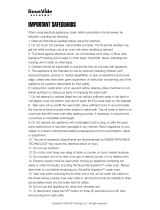
5
electrical rating should be at least as great as the electrical rating
of the machine.
NOTE: This unit is intended for indoor use at commercial food
service establishments. It is not intended for household, industrial
or laboratory use. Operate unit at room temperature and if not, allow
time for unit to reach room temperature.
NOTE: For the most accurate temperature control, be sure to place
lid on vessel when in use.
NOTE: This unit will only properly operate when lled using tap
water. Pure (ltered) water or distilled water cannot be detected as
there are no dissolved solids in these water types. Salt can be added
to pure (ltered) water if needed, but regular tap water is highly
recommended for use.
NOTE: Heat water only. Do not use this unit to heat oil, grease or
other liquids. Other liquids may become unstable and hazardous.
INTRODUCTION TO SOUS VIDE COOKING
Sous vide (pronounced soo-veed) describes a method of cooking
foods, sealed in plastic vacuum bags, in a water bath at precisely
controlled temperatures, often much lower than those used in
traditional ovens, but for longer periods of time. The technique was
rst developed in France and named Sous Vide, French for “under
vacuum,” though it would more correctly be called “without much
air,” since the vacuum sealing doesn’t truly remove all the air from the
bag. Removing most of the air from the bags, however, does reduce
the chance of bacterial growth and spoilage. And the vacuum-sealed
pouches prevent evaporation and the loss of avor and nutrition,
keeping the foods cooked sous vide moist, tender and avorful.
The high-precision thermostat of the Waring
®
Thermal Circulators
water bath maintains the temperature with a tight window around
the set target temperature, so food can be cooked to the perfect
temperature effortlessly. Steaks prepared with the sous vide method
can be cooked to the desired temperature throughout, instead of
charred on the outside, overcooked below that, and perfect just in
the center.
A medium-rare steak cooked sous vide will be medium rare from
edge to edge; a medium steak will be medium throughout; a
medium-well steak, the same all the way through. No guesswork.
No critical timing. No chance of overcooking.
Check out waringcommercialproducts.com to see our vacuum
sealing systems for food storage and sous vide cooking.



















